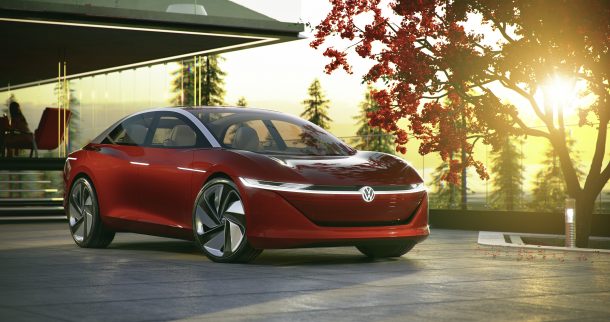Volkswagen Strips Down Its Vizzion, Promises a Semi-conventional Sedan

Volkswagen’s Vizzion of the future — a fully autonomous concept car with an all-knowing hologram chauffeur and suicide doors — just came back down to Earth. The sedan will now start life as a normal car, albeit one with two electric motors and all-wheel drive.
Positioned as the flagship of Volkswagen’s upcoming line of I.D.-badged electric models, the Vizzion is on track to start production in 2022. With this car, VW gains a lower-priced alternative to vehicles like Tesla’s Model S and Porsche’s Mission E.
As we told you recently, the Vizzion concept makes a lot of promises it can’t follow through on. Not yet, anyway. Production vehicles with full Level 5 autonomy, controlled by gestures and voice commands, are still the stuff of future-speak mobility conferences, not the real world.
However, while VW still intends to install the capability once it becomes available, the Vizzion remains useful as a conventional electric car. VW brand chief Herbert Diess told media at the Geneva Motor Show that the production version, due no later than 2022, will carry over the styling cues of the concept. Again, there’ll be no suicide doors in this model’s future (blame cost savings, development chief Frank Welsch said), but expect a fastback design and spacious cabin.
Diess claims the long-wheelbase model is smaller in size than a Phaeton, but the positioning of the propulsion kit means there’s extra room inside. Even the trunk stands to gain space, with 20 cubic feet of cargo volume.
Below the Vizzion in VW’s EV food chain is the compact I.D. hatch, the I.D. Crozz crossover, and the I.D. Buzz microbus (God, these names are tedious), each riding atop VW’s electric MEB platform. The Vizzion’s massive, 111 kWH battery lies flat below the vehicle’s floor. Total output from both electric motors amounts to 302 horsepower and a pile of torque available from a standstill, all funneled through both axles. While 413 miles of range sounds outstanding, that’s based on the unrealistic European cycle. Expect around 300 miles instead.
It looks like the production version of the Vizzion should roll out after the launch of the latter-day microbus. The first I.D.-badged vehicles, the I.D. and I.D. Crozz, enter production in 2020.
[Source: Automotive News Europe] [Images: Volkswagen Group]

More by Steph Willems
Latest Car Reviews
Read moreLatest Product Reviews
Read moreRecent Comments
- ToolGuy Please allow me to listen to the podcast before commenting. (This is the way my mind works, please forgive me.)
- ToolGuy My ancient sedan (19 years lol) matches the turbo Mazda 0-60 (on paper) while delivering better highway fuel economy, so let's just say I don't see a compelling reason to 'upgrade' and by the way HOW HAVE ICE POWERTRAIN ENGINEERS BEEN SPENDING THEIR TIME never mind I think I know. 😉
- FreedMike This was the Official Affluent-Mom Character Mobile in just about every TV show and movie in the Aughts.
- Offbeat Oddity The RAV4, and I say this as someone who currently owns a 2014 CR-V. My aunt has a 2018 CR-V that has had a lot of electrical issues, and I don't trust the turbo and CVT to last as long as Toyota's NA engine and 8-speed automatic. Plus, the RAV4 looks sportier and doesn't have the huge front overhang.
- Offbeat Oddity I'd go with Mazda, especially now that there's no more cylinder deactivation on the 2024 NA motor. It's around $4-5k less than the Toyota with similar equipment, and I think reliability is probably very close between them.Regarding reliability, hasn't this generation of RAV4 taken a hit? I know it's not rated as highly in Consumer Reports, and there were teething issues during the first few years. I'm surprised it's not mentioned in more reviews- even Jack Baruth's. I'm sure the bugs have been worked out by now, though.




































Comments
Join the conversation
Will it come from the factory with Fuzion tires?
I hope VW isn’t testing batteries on humans.